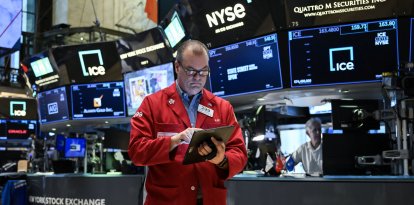Economic freedom, the engine for the success of several U.S. states
An exhaustive analysis by researcher Richard Hanania shows how the most economically free states surpass the most interventionist ones in terms of GDP growth and population attraction.
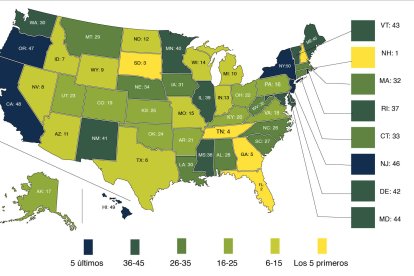
Mapa de libertad económica del año 2022 (Cato Institute).
The debate over which political force – the Republican Party or the Democratic Party – is better in terms of governance is often perceived as a matter of subjective opinion related to deeply held ideologies and dogmas. However, a recent analysis carried out by researcher Richard Hanania sheds light on the impact of the policies implemented by the authorities of different states on economic growth and population attraction beyond the usual political debate related to issues such as the health system, education, or civil rights, among others.
The data in this study, based on information collected from 1980 to the present, supports the notion that economic freedom is a crucial factor influencing state success. States that adopt policies that promote lower taxes, less regulation, and more financial freedom tend to perform better in terms of GDP growth and population attraction.
This raises important implications for the public policy debate. Instead of relying solely on partisan ideologies, policymakers could benefit from looking at objective data on the impact of economic measures on state success.
This analysis also raises important questions about how public policies are formulated at the state level. Why do some states continue to take measures that seem at odds with data on economic and demographic success? How can lagging states learn from the achievements of those who have embraced economic freedom?
According to the study, between 2021 and 2022 alone, 8,200,000 people moved to different states, representing 2.4% of the entire country. Furthermore, the country attracts a large number of immigrants, and currently, more than 45,000,000 of them must also choose where to live. The election of natives and newcomers should, in theory, provide us with some of the best evidence we can find about the effectiveness of various government policies.
Regarding taxes, the author points out that the most fundamental difference in economic policy revolves around the degree to which state authorities take citizens' money. Unlike the federal government, states cannot print dollars, so there is a direct link between taxes and spending.

(Tax Foundation)
(Tax Foundation)
The study shows that New York, Connecticut, Hawaii, Vermont and California have the highest tax burdens. In contrast, the lowest are found in Alaska, Wyoming, Tennessee, South Dakota and Michigan. While this appears to correspond to each state's red and blue orientation, Hanania says there is a correlation that is far from perfectly reflective of the states' ideological leanings. For example, the author mentions that Pennsylvania collects approximately the same amount of taxes as Montana and Idaho, even though the citizens of the latter two are usually considered red, in contrast to the former, whose population usually leans towards the blue candidates.
States differ not only in taxes but also in other aspects, such as labor market regulation. In this sense, the author clarifies that although there is a federal minimum wage of 7.25 dollars per hour, there are 16 states that do not exceed that amount, however there are 34 that do, with California being the highest, with 16 dollars per hour. Some jurisdictions have anti-discrimination laws that go beyond federal requirements, while others do not.
Below is the map published by the Cato Institute classifying states by economic freedom from the year 2022.

(Cato Institute)
(Cato Institute)
Freer states receive more people and have better economies
According to the report, the states with the best population growth results are concentrated in the western and southern mountains. In general, the increase is significantly slower in the center of the country and the northeast, and in some cases, they even lose inhabitants.
However, it is necessary to clarify that weighing the data by population size is helpful since, as Hanania points out, many small states are subject to larger economic forces that determine their destiny. North Dakota, for example, has been experiencing booms and busts based on oil production since the mid-2000s. The price of that commodity is likely more important to its fate than the decisions taken by the authorities.
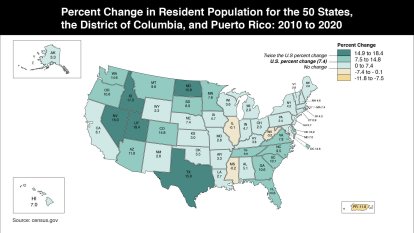
(Census.gov)
(Census.gov)
On the other hand, large states are not usually dominated by one or two industries, so the authorities' measures have a more significant impact on the results.
In addition to changes related to population size, it is also necessary to look at GDP growth over time. There's a clear pattern here: red states grow faster.
As the report demonstrates, the results are consistent. Although, at a given moment in history, there may be variations due to various factors, such as regional booms and busts and the discovery of natural resources, among other events, The truth is that these are momentary exceptions.
The relationship between population growth and economic freedom is very consistent and clearer in states with larger and more diverse populations.
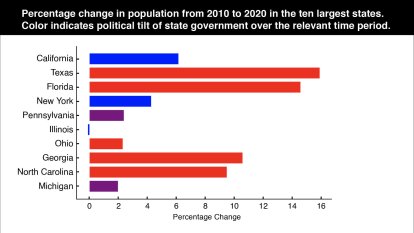
(Census.gov)
(Census.gov)
Given all of the data mentioned above, the author highlights that looking at economic freedom scores is more important than considering which states are Republican or Democratic. Haniana mentions that, for example, the fact that Mississippi, Louisiana, and West Virginia have not done well in recent decades is not because they are red states but because they have obtained a medium or low ranking in terms of economic freedom.
Blue states have been getting worse in recent years
The data presented above shows demographic trends until 2020. Regarding what has happened in the post-pandemic years, Hanania maintains that the situation has worsened for blue states. He says California and Hawaii have not performed particularly well historically but have consistently increased their population every decade from 1980 to 2020. However, the fact that the number of inhabitants in both states is now shrinking indicates that their problems are getting worse.
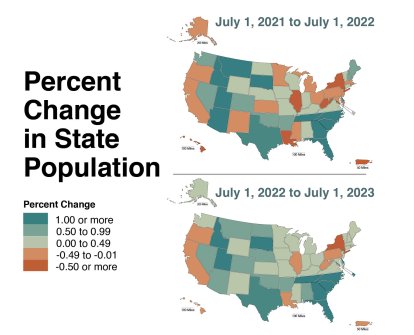
(Census.gov)
(Census.gov)
The author adds that the situation in Oregon and Washington has also deteriorated dramatically, even though they have been high-performing states in the past. Hanania reveals that Oregon is in the red while Washington is barely growing. Meanwhile, neighboring Republican-governed Idaho continues to boom.
Hanania notes that measures taken during the pandemic in West Coast states and Hawaii were particularly damaging.
Hawaii, for example, did not lift its indoor mask mandate until March 2022, a year and a half after Florida Governor Ron DeSantis prohibited localities from imposing such restrictions.
Hanania is not optimistic about the future, noting that the gap between economically free and interventionist states could be similar or even widen further.
In California, the Department of Finance projects that the state's population will remain essentially unchanged through 2060. But after decades of losing poor residents, the wealthy are now fleeing, too. Things don't seem to be going well in Illinois either, which is suffering from the worst pension crisis in the country.
How much does the climate influence?
People want to live in dry places where the sun shines. In fact, maps of population movement and GDP growth resemble climate maps.

(NREL)
(NREL)
However, even in states with similar climates, it is observed that the most economically free ones have grown at a significantly faster rate than their neighbors.
For example, Hanania mentions the case of Arizona and New Mexico, two extremely hot desert states located next to each other. However, being economically freer, Arizona has had faster growth over the past few decades.

(Regional Economic Analysis Project)
(Regional Economic Analysis Project)
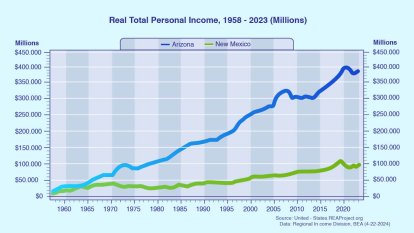
(Regional Economic Analysis Project)
(Regional Economic Analysis Project)
Another case is New Hampshire and Vermont, two neighbors that do not look very different either. However, between 2010 and 2022, the former increased its GDP by 23.7%, while the latter increased it by 10.5%. This is, of course, because New Hampshire is more economically free. Furthermore, Hanania highlights that the population in this state has increased every decade from 1980 to 2020.
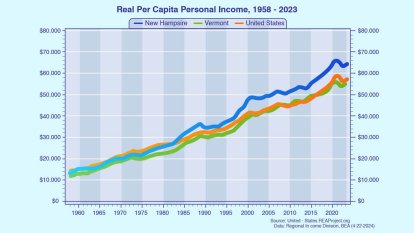
(Regional Economic Analysis Project)
(Regional Economic Analysis Project)
Another interesting case is that of the blue states of California and Hawaii, whose performance is not good despite having pleasant climates and natural advantages.
Economic freedom works around the world
Hanania also considers the importance of economic freedom based on the observation of data both nationally and internationally, pointing out the fact that the United States is more prosperous than Europe, the significant change experienced by ex-communist countries after the fall of the Wall of Berlin, and the rise of East Asian nations as they moved away from top-down control.
Hanania criticizes those who consider the mixed system, adopted by most of the developed world, is better than a purely capitalist or socialist system. According to the author, no country has too much capitalism, but what is clear, he indicates, is that the freest nations do better than the least free ones. Within the United States, the red states are preferable to the blue ones in terms of economics.
The author believes that if the economy in the United States has performed relatively well, it is not due to the increase in economic interventionism, as during the New Deal or the Great Society, but because the country has been significantly freer than other developed nations.
Hanania suggests that the United States' economic situation would have been even better if the federal government had not expanded.
Furthermore, the author states that if a purely communist country kills the motivation to work hard, shouldn't a mixed economy state do the same, only to a lesser extent?
Hanania concludes that 40 years of data all pointing in the same direction cannot be easily dismissed, so economic freedom must be given the importance it deserves.
RECOMMENDATION
